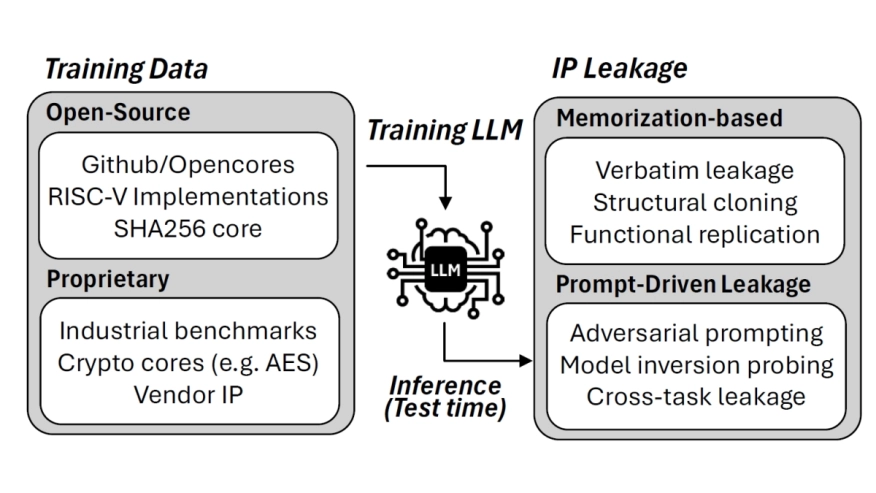CircuitGuard: Mitigating LLM Memorization in RTL Code Generation Against IP Leakage
By Nowfel Mashnoor, Mohammad Akyash, Hadi Kamali, Kimia Azar
Department of Electrical and Computer Engineering (ECE), University of Central Florida, USA

Abstract
 Large Language Models (LLMs) have achieved remarkable success in generative tasks, including register-transfer level (RTL) hardware synthesis. However, their tendency to memorize training data poses critical risks when proprietary or security-sensitive designs are unintentionally exposed during inference. While prior work has examined memorization in natural language, RTL introduces unique challenges: In RTL, structurally different implementations (e.g., behavioral vs. gate-level descriptions) can realize the same hardware, leading to intellectual property (IP) leakage (full or partial) even without verbatim overlap. Conversely, even small syntactic variations (e.g., operator precedence or blocking vs. non-blocking assignments) can drastically alter circuit behavior, making correctness preservation especially challenging. In this work, we systematically study memorization in RTL code generation and propose CircuitGuard, a defense strategy that balances leakage reduction with correctness preservation. CircuitGuard (1) introduces a novel RTL-aware similarity metric that captures both structural and functional equivalence beyond surface-level overlap, and (2) develops an activation-level steering method that identifies and attenuates transformer components most responsible for memorization. Our empirical evaluation demonstrates that CircuitGuard identifies (and isolates) 275 memorization-critical features across layers 18-28 of Llama 3.1-8B model, achieving up to 80% reduction in semantic similarity to proprietary patterns while maintaining generation quality. CircuitGuard further shows 78-85% cross-domain transfer effectiveness, enabling robust memorization mitigation across circuit categories without retraining.
Large Language Models (LLMs) have achieved remarkable success in generative tasks, including register-transfer level (RTL) hardware synthesis. However, their tendency to memorize training data poses critical risks when proprietary or security-sensitive designs are unintentionally exposed during inference. While prior work has examined memorization in natural language, RTL introduces unique challenges: In RTL, structurally different implementations (e.g., behavioral vs. gate-level descriptions) can realize the same hardware, leading to intellectual property (IP) leakage (full or partial) even without verbatim overlap. Conversely, even small syntactic variations (e.g., operator precedence or blocking vs. non-blocking assignments) can drastically alter circuit behavior, making correctness preservation especially challenging. In this work, we systematically study memorization in RTL code generation and propose CircuitGuard, a defense strategy that balances leakage reduction with correctness preservation. CircuitGuard (1) introduces a novel RTL-aware similarity metric that captures both structural and functional equivalence beyond surface-level overlap, and (2) develops an activation-level steering method that identifies and attenuates transformer components most responsible for memorization. Our empirical evaluation demonstrates that CircuitGuard identifies (and isolates) 275 memorization-critical features across layers 18-28 of Llama 3.1-8B model, achieving up to 80% reduction in semantic similarity to proprietary patterns while maintaining generation quality. CircuitGuard further shows 78-85% cross-domain transfer effectiveness, enabling robust memorization mitigation across circuit categories without retraining.
To read the full article, click here
Related Semiconductor IP
- Network-on-Chip (NoC)
- 12-bit, 400 MSPS SAR ADC - TSMC 12nm FFC
- UCIe PHY (Die-to-Die) IP
- UCIe-S 64GT/s PHY IP
- UA Link DL IP core
Related Articles
- Paving the way for the next generation of audio codec for True Wireless Stereo (TWS) applications - PART 5 : Cutting time to market in a safe and timely manner
- Commentary: Synopsys memory IP users seek RTL source code
- Using SystemVerilog Assertions in RTL Code
- Tips for efficient embedded code generation
Latest Articles
- David vs. Goliath: Can Small Models Win Big with Agentic AI in Hardware Design?
- RoMe: Row Granularity Access Memory System for Large Language Models
- Analog Foundation Models
- Modeling and Optimizing Performance Bottlenecks for Neuromorphic Accelerators
- RISC-V Based TinyML Accelerator for Depthwise Separable Convolutions in Edge AI